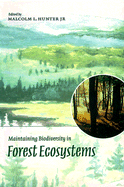Book contents
- Frontmatter
- Contents
- List of contributors
- Foreword
- Preface
- Part I Introduction
- Part II The macro approach, managing forest landscapes
- 3 Species composition
- 4 Dynamic forest mosaics
- 5 Abiotic factors [161]
- 6 Forest edges
- 7 Islands and fragments
- 8 Riparian forests
- 9 Forested wetlands
- Part III The micro approach, managing forest stands
- Part IV Synthesis and implementation
- Index
4 - Dynamic forest mosaics
Published online by Cambridge University Press: 20 February 2010
- Frontmatter
- Contents
- List of contributors
- Foreword
- Preface
- Part I Introduction
- Part II The macro approach, managing forest landscapes
- 3 Species composition
- 4 Dynamic forest mosaics
- 5 Abiotic factors [161]
- 6 Forest edges
- 7 Islands and fragments
- 8 Riparian forests
- 9 Forested wetlands
- Part III The micro approach, managing forest stands
- Part IV Synthesis and implementation
- Index
Summary
A stand of forest trees is quite tangible to us; however, many of the processes that shape the biological diversity of that stand are invisible because they relate to events that have happened during some distant past or because they occur in the landscape beyond the area of forest we can see. Some scientists have called this phenomena ‘the invisible present’ and the ‘invisible place’ (Magnuson 1990, Swanson and Sparks 1990) meaning that the wrong temporal and spatial perspectives can produce erroneous conclusions. Humans and their management systems have typically perceived ecosystems at short distances and over short time frames. However, processes such as dispersal, disturbance, and succession, which control the state and dynamics of ecosystems and biological diversity, operate across a much wider range of spatial and temporal scales. This chapter is about seeing these large-scale temporal and spatial phenomena and understanding how they relate to the conservation of biological diversity.
Understanding the dynamics and heterogeneity of natural forest landscapes has become very important as management objectives for forests increasingly include the maintenance of biological diversity. Using natural or semi-natural ecosystems as a template for management is quite challenging, requiring understanding not only the patterns of forest change, but also the processes that underlie them. Recent advances in theory and empirical studies of vegetation ecology and landscape ecology indicate that if goals of maintaining biological diversity across landscapes are to be achieved in the long run, then management and conservation need to broaden their focus to include variability, scale, pattern, disturbance, and biotic processes.
- Type
- Chapter
- Information
- Maintaining Biodiversity in Forest Ecosystems , pp. 95 - 160Publisher: Cambridge University PressPrint publication year: 1999
- 62
- Cited by

